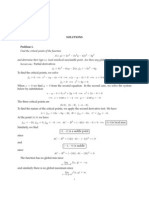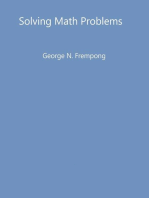Assignment 2
Uploaded by
Shivam PatidarAssignment 2
Uploaded by
Shivam PatidarAssignment - 2
(Functions of Two Variables: Limit, Continuity, Differentiability, Extreme Values)
In Questions 1-3, (a) find the function’s domain, (b) find the function’s range, (c) find the
boundary of the function’s domain, (d) determine if the domain is an open region, a closed
region, or neither, (e ) decide if the domain is bounded or unbounded and (f) plot the contour for
the level curves at z=0, 1, 4, 9.
f ( x, y ) = y−x
1.
f ( x, y ) = 4 x 2 + 9 y 2
2.
f ( x, y ) = x 2 − y 2
3.
Using the Limit Definition, in question 4–6 given a function ƒ(x, y) and a positive number ɛ,
show that there exists a δ > 0 such that for all (x, y), we have x2 + y2 < δ implying
f (x, y) − f (0,0) < ε
4. f (x, y) = x 2 + y2, ε = 0.01
y
5. f (x, y) = , ε = 0.05
x2 + 1
x+y
6. f (x, y) = , ε = 0.02
2 + cosx
Using the Partial Derivative Definition (using limit concept), in question 7–8 given a function ƒ
∂f ∂f
(x, y), compute the partial derivatives , of the functions at the specified points
∂x ∂ y
7. f (x, y) = 4 + 2x − 3y − xy2, at ( − 2,1)
sin(x 3 + y 4)
, (x, y) ≠ (0,0)
8. f (x, y) = x2 + y2 , at (0,0)
0, (x, y) = (0,0)
Find the slopes as required:
9. Let ƒ (x, y) = 2x + 3y – 4. Find the slope of the line tangent to this surface at a point (2,–1)
and lying in the a. plane x = 2, b. plane y = –1.
10. Let ƒ (x, y) = x2 + y3. Find the slope of the line tangent to this surface at the point (–1, 1)
and lying in the a. plane x = –1, b. plane y = 1.
In Questions 11–12, find an equation for the plane that is tangent to the given surface at the given
point
11. z = ln(x 2 + y 2), at (1,0, 0)
12. z = 4x 2 + y 2, at (1,1, 5)
Find all the local maxima, local minima, and saddle points of the functions in questions 13–15
13. ƒ (x, y) = 6x2 – 2x3 + 3y2 + 6xy
14. ƒ (x, y) = e2x cos y
15. ƒ (x, y) = ln (x + y) + x2 – y
Find the absolute maxima and minima of the functions on the given domains in questions 16–17
16. ƒ (x, y) = x2 – xy + y2 + 1 on the closed triangular plate in the first quadrant bounded
by the lines x = 0, y = 4, y = x.
17. T (x, y) = x2 + xy + y2 – 6x on the rectangular plate 0 ≤ x ≤ 5, − 3 ≤ y ≤ 3
Use method of Lagrange Multipliers to find extreme values in question 18
18. Ant on a metal plate: The temperature at a point (x, y) on a metal plate is
T(x, y) = 4x2 – 4xy + y2.
An ant on the plate walks around the circle of radius 5 centered at the origin. What are the
highest and lowest temperatures encountered by the ant?
You might also like
- Department of Mathematics MAL 110 (Mathematics I) Tutorial Sheet No. 3 Several Variables, Maxima/Minima and Euler's TheoremNo ratings yetDepartment of Mathematics MAL 110 (Mathematics I) Tutorial Sheet No. 3 Several Variables, Maxima/Minima and Euler's Theorem2 pages
- Solutions To Tutorial 2 (Week 3) : Lecturers: Daniel Daners and James ParkinsonNo ratings yetSolutions To Tutorial 2 (Week 3) : Lecturers: Daniel Daners and James Parkinson9 pages
- Workbook.limits+and+continuity.solutionsNo ratings yetWorkbook.limits+and+continuity.solutions29 pages
- MH1811 Tutorial 1 - MC - 2020 - FN - LmtsNo ratings yetMH1811 Tutorial 1 - MC - 2020 - FN - Lmts2 pages
- Calculus II 24-25 - Problems for Training #4No ratings yetCalculus II 24-25 - Problems for Training #42 pages
- Solutions To Tutorial 2 (Week 3) : Lecturers: Daniel Daners and James ParkinsonNo ratings yetSolutions To Tutorial 2 (Week 3) : Lecturers: Daniel Daners and James Parkinson10 pages
- Multivariable Func +partial Derrivative Çalışma SorularıNo ratings yetMultivariable Func +partial Derrivative Çalışma Soruları13 pages
- Solution To Practice Problems For Test 2No ratings yetSolution To Practice Problems For Test 26 pages
- Indian Institute of Technology Ropar Department of Mathematics MA101 - CalculusNo ratings yetIndian Institute of Technology Ropar Department of Mathematics MA101 - Calculus2 pages
- MH1811 Tutorial 1 - MC - 2020 - FN - LmtsNo ratings yetMH1811 Tutorial 1 - MC - 2020 - FN - Lmts2 pages
- Ex#4_Function of Several Variables(14.1,14.2)No ratings yetEx#4_Function of Several Variables(14.1,14.2)2 pages
- Bachelor'S Degree Programme (BDP) Term-End Examination June, 2017No ratings yetBachelor'S Degree Programme (BDP) Term-End Examination June, 20174 pages
- Multivariable Calculus Practice Midterm 2 Solutions Prof. FedorchukNo ratings yetMultivariable Calculus Practice Midterm 2 Solutions Prof. Fedorchuk5 pages
- Homework 22 Solutions: Math 21a Spring, 2014No ratings yetHomework 22 Solutions: Math 21a Spring, 20145 pages



























































